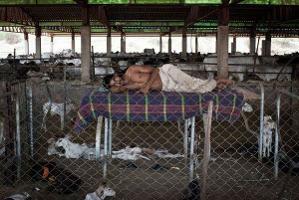May 27, 2013
NEW DELHI: When night falls in this gritty capital, gangs troll the darkened streets looking for easy prey among a portion of the city's vast homeless population; thousands have been rounded up and carried off in trucks in recent years.

May 27, 2013
NEW DELHI: When night falls in this gritty capital, gangs troll the darkened streets looking for easy prey among a portion of the city's vast homeless population; thousands have been rounded up and carried off in trucks in recent years.

Taking a break at Shri Mataji Gaushala, a shelter in UP, for thousands of cattle. The eating of beef is becoming more common in India.
The police say they have increased patrols and set up roadblocks in an effort to stop the trafficking. In some cases, officers have infiltrated gangs in hopes of catching them in the act. But the brutal kidnappings continue, and the victims — scrawny cows, which are slowly losing their sacred status among some in India — are slaughtered and sold for meat and leather.
Cattle rustling, called "lifting" here, is a growing scourge in New Delhi, as increasingly affluent Indians develop a taste for meat, even the flesh of cows, which are considered sacred in Hinduism. Criminals round up some of the roughly 40,000 cattle that wander the streets of this megacity and sell them to illegal slaughterhouses located in villages not far away.
Many of the cattle in Delhi are part of dairy operations and their owners have neither the land nor the money to keep them penned. So the animals graze on grassy medians or ubiquitous piles of trash. Others too old to be milked are often abandoned and left to wander the streets until they die — or get picked up by the rustlers.
Posses of police officers give chase to the outlaws, but the desperados — driving souped-up dump trucks — think little of ramming police cars and breaking through barricades. They have even pushed cows into the pathways of their pursuers, forcing horrified officers to swerve out of the way to avoid what for many is still a grievous sin.
"These gangs mostly go after stray cattle, but they will also steal motorcycles and scooters," one police officer, Bhisham Singh, said in an interview. "They kidnapped a woman recently and gang-raped her."
Behind the cattle rustling is a profound shift in Indian society. Meat consumption — chicken, primarily — is becoming acceptable even among Hindus. India is now the world's largest dairy producer, its largest cattle producer and its largest beef exporter, having surpassed Brazil last year, according to the United States Department of Agriculture.
Much of that exported beef is from buffalo (India has half of the world's buffalo population), which are not considered holy. But officials in Andhra Pradesh recently estimated that there are 3,100 illegal slaughterhouses in the state compared with just six licensed ones, and a recent newspaper investigation found that tens of thousands of cattle are sold annually for slaughter from a market in just one of that state's 64 districts. Killing cows is illegal in much of India, and some states outlaw the possession of cow meat.
Much of the illicit beef is probably sold as buffalo, an easy way to hide a sacrilegious act. But sometimes it makes its way to meat sellers in Delhi whose cellphone numbers are passed around in whispers. Steaks can be ordered from these illicit vendors in transactions that are carried out like drug deals.
Beef from cattle is also widely consumed by Muslims and Dalits, among India's most marginalized citizens. Indeed, meat consumption is growing the most among the poor, government statistics show, with overall meat eating growing 14 percent from 2010 to 2012.
Anuj Agrawal, 28, said he grew up in a strictly vegetarian Hindu household but tried chicken for the first time in his teens when he was at a restaurant with friends. He now eats every kind of meat, including beef steaks and burgers. "Once you taste meat, you're not going back to just fruits and vegetables," Mr Agrawal said.
He says many of his friends have made similar transitions. But he never eats meat with his grandparents: "I would be excommunicated if I did, so I go pure 'veg' when I'm with them. I want to inherit something."
To some extent, the growing acceptance of beef is a result of the government's intense focus on increasing milk production, which has led to a proliferation of foreign cattle breeds that do not elicit the same reverence as indigenous ones, said Clementien Pauws, president of Karuna Society for Animals and Nature, an animal welfare agency in Andhra Pradesh.
"Cows are all about business and money now, not religion," Ms Pauws said. "They're all taken to slaughterhouses. It's terrible."
This is not to say that eating beef from cattle is widely accepted. The vast majority of Hindus still revere cows, and the Bharatiya Janata Party, one of the country's two major political parties, has demanded that laws against cow slaughter be strengthened.
Some landlords even refuse to rent to those who confess to a taste for meat.
But the demand for beef keeps rising, many here say, and with it the prevalence of cattle rustling. Last year, the police in Delhi arrested 150 rustlers, a record number. This year, arrests have continued to surge, Mr. Singh said.
Typically, the rustlers creep into the city at night. When the criminals spot stray cattle and few onlookers they stop the truck, push out a ramp and use a rope to lead the cow to its doom.
The thieves can usually fit about 10 cows on a truck, and each fetches 5,000 rupees — about $94. In a country where more than 800 million people live on less than $2 a day, a single night's haul of more than $900 represents serious temptation.
One man who has helped the police in neighboring Uttar Pradesh said the rustlers were often able to bribe their way to freedom. "Even if they're sent to jail, they come out in 10 to 15 days and commit the same crimes again," said the man, who did not want his name used for fear of reprisals.
The unfortunate fate of some of Delhi's cattle has led some Hindus to establish cattle shelters on the fringes of the metropolitan region. One of the largest is Shri Mataji Gaushala, where thousands of cattle live on about 42 acres.
Sometimes, the rescue comes too late. Brijinder Sharma, the shelter manager, whose office walls are decorated with drawings of Lord Krishna hugging a calf, showed a video of a truck packed with cattle that was seized on its way to an illegal slaughterhouse. Many of the cows had already died of heat exhaustion.
"The social and religious status of cows has been under attack in India," Mr. Sharma said. He hopes that his shelter, which has an annual budget of $5.4 million, underwritten almost entirely by wealthy Indians who have emigrated to the United States, will help reverse that trend.
The afternoon feeding at the shelter attracted a crowd of happy onlookers. Abhishek, a one-named cowhand, called out among the lowing throng: "Sakhi! Sakhi!" A large cow with huge horns rushed to the front of the herd, and Mr. Abhishek kissed her on the nose. The cow responded by licking one entire side of his face, and Mr Abhishek beamed.
Courtesy: NYT
















































































































